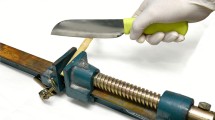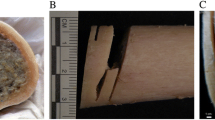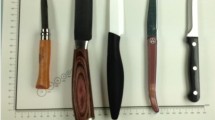Abstract
Although evidence of sharp-force trauma on the human body, particularly the skeleton, can be extremely useful in providing information regarding the manner and context of death, there is still a lack of necessary detail available to the investigator. Using ribs, radii, scapulae, vertebrae and carpal bones, this study demonstrated that distinctions could be made between the stab marks left by serrated blades and those of non-serrated blades. Low power and scanning electron microscopy were used to record distinctive ‘T’-shaped stab marks from non-serrated blades and ‘Y’-shaped stab marks from serrated blades. In addition, elemental evidence of the presence of the blade in the stab-mark kerf was recoverable even when no metal fragment was visible.




Similar content being viewed by others
References
Knight B (1975) The dynamics of stab wounds. Forensic Sci 6:249–255
Hunt AC, Cowling RJ (1991) Murder by stabbing. Forensic Sci Int 52:107–112
Hainsworth SV, Delaney RJ, Rutty GN (2008) How sharp is sharp? Towards quantification of the sharpness and penetration ability of kitchen knives used in stabbings. Int J Legal Med 122(4):281–291
Ormstad K, Karlsson T, Enkler L, Law B, Rajs J (1986) Patterns in sharp force fatalities—a comprehensive forensic medical study. J Forensic Sci 31:529–542
Bamasr A, de la Grandmaison GL, Durigon M (2003) Frequency of bone/cartilage lesions in stab and incised wounds fatalities. Forensic Sci Int 131:131–133
Schmidt U, Pollak S (2006) Sharp force injuries in clinical forensic medicine—findings in victims and perpetrators. Forensic Sci In 159:113–118
Karger B, Vennemann B (2001) Suicide by more than 90 stab wounds including perforation of the skull. Int J Legal Med 115:167–169
Rutty GN (2007) Soft tissue trauma. In: Thompson TJU, Black SM (eds) Forensic human identification: an introduction. CRC, Boca Raton, pp 113–126
Bartelink EJ, Wiersema JM, Demaree RS (2001) Quantitative analysis of sharp-force trauma: an application of scanning electron microscopy in forensic anthropology. J Forensic Sci 46:1288–1293
Bello SM, Soligo C (2008) A new method for the quantitative analysis of cutmark micromorphology. J Arch Sci doi:10.1016/j.jas.2007.10.018
Alunni-Perret V, Muller-Bolla M, Laugier J-P et al (2005) Scanning electron microscopy analysis of experimental bone hacking trauma. J Forensic Sci 50:1–6
Humphrey JH, Hutchinson DL (2001) Macroscopic characteristics of hacking trauma. J Forensic Sci 46:228–233
Saville PA, Hainsworth SV, Rutty GN (2007) Cutting crime: the analysis of the “uniqueness” of saw marks on bone. Int J Legal Med 121:349–358
Kieser J, Bernal V, Gonzalez P et al (2008) Analysis of experimental cranial skin wounding from screwdriver trauma. Int J Legal Med 122:179–188
Herrmann NP, Bennett JL (1999) The differentiation of traumatic and heat-related fractures in burned bone. J Forensic Sci 44:461–469
De Gruchy S, Rogers TL (2002) Identifying chop marks on cremated bone: a preliminary study. J Forensic Sci 47:933–936
Outram AK, Knüsel CJ, Knight S, Harding AF (2005) Understanding complex fragmented assemblages of human and animal remains: a fully integrated approach. J Archaeol Sci 32:1699–1710
Pickering TR, Egeland CP (2006) Experimental patterns of hammerstone percussion damage on bones: implications for inferences of carcass processing by humans. J Archaeol Sci 33:459–469
Konopka T, Bolechala F, Strona M (2006) An unusual case of corpse dismemberment. Am J Forensic Med Pathol 27:163–165
Patrick P (2006) Approaches to violent death: a case study from Early Medieval Cambridge. Int J Osteoarchaeol 16:347–354
Knüsel CJ, Outram AK (2006) Fragmentation of the body: comestibles, compost, or customary rite. In: Gowland R, Knüsel CJ (eds) Social archaeology of funerary remains. Oxbow Books, Oxford, pp 253–278
Rawson RB, Hansen Starich G, Rawson RD (2000) Scanning electron microscopic analysis of skin resolution as an aid in identifying trauma in forensic investigations. J Forensic Sci 45:1023–1027
Thali MJ, Taubenreuther U, Karolczak M, Braun M, Brueschweiler W, Kalender WA, Dirnhofer R (2003) Forensic microradiology: micro-computed tomography (Micro-CT) and analysis of patterned injuries inside of bone. J Forensic Sci 48:1336–1342
Bonte W (1975) Tool marks in bone and cartilage. J Forensic Sci 20:315–323
Bajanowski T, Kohler H, Schmidt PF et al (2000) The cloven hoof in legal medicine. Int J Legal Medicine 114:346–348
Acknowledgements
We would like to thank our fellow Forensic Biology Research Kernel members for their support and help throughout this project. Ken Robinson provided much assistance with the SEM. Dr. Becky Gowland (Durham University) gave very useful comments and suggestions on earlier drafts of this paper.
Author information
Authors and Affiliations
Corresponding author
Rights and permissions
About this article
Cite this article
Thompson, T.J.U., Inglis, J. Differentiation of serrated and non-serrated blades from stab marks in bone. Int J Legal Med 123, 129–135 (2009). https://doi.org/10.1007/s00414-008-0275-x
Received:
Accepted:
Published:
Issue Date:
DOI: https://doi.org/10.1007/s00414-008-0275-x




